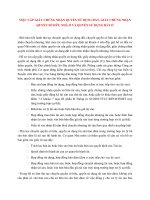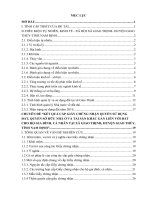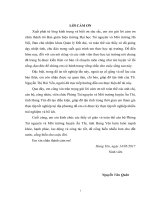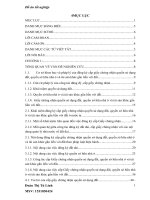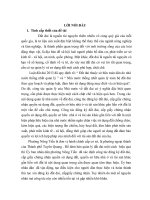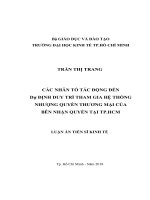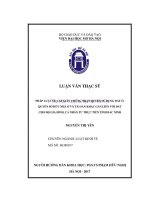Các yếu tố xã hội quyết định sức khỏe: công bằng, giới và nhân quyền
Bạn đang xem bản rút gọn của tài liệu. Xem và tải ngay bản đầy đủ của tài liệu tại đây (415.12 KB, 34 trang )
<span class="text_page_counter">Trang 1</span><div class="page_container" data-page="1">
<b>Các yếu tố xã hội quyết định sức khỏe: công bằng, giới và nhân quyền </b>
<small>Hội thảo tập huấn, 3-4 tháng 12- 2009, TP. Hồ Chí Minh, Việt Nam</small>
</div><span class="text_page_counter">Trang 2</span><div class="page_container" data-page="2"><b>Phần 4:</b>
<b>Nhân quyền và sức khỏe</b>
</div><span class="text_page_counter">Trang 3</span><div class="page_container" data-page="3"><b>4.1 Nhân quyền là gì ?</b>
</div><span class="text_page_counter">Trang 4</span><div class="page_container" data-page="4">Minh Châu là một cơ gái 18 tuổi. Cô đến khám tại trung tâm y tế nhưng không gặp được bác sĩ. Nhân viên trung tâm cho biết cô nên đi về. Minh Châu sống tại khu vực vùng sâu vùng xa của xã. Cô
chưa bao giờ được đi học và khơng biết đọc. Năm ngối, khi vụ mùa thất bát cô quyết định bỏ lên thành phố. Cô nghe người ta nói lên thành phố làm gái mại dâm có thể kiếm được nhiều tiền và có thể gửi về cho cha mẹ. Nay, cơ bị mắc bệnh và tìm đến trung tâm y tế để khám bệnh. Nhân viên trung tâm yêu cầu cơ trình giấy tờ tùy thân nhưng cơ khơng mang theo. Cô cũng không biết điền vào các mẫu đơn vì vậy cơ khơng thể điều trị ở đây.
Một nhân viên y tế nói với Minh Châu rằng cơ
đừng lấy làm ngạc nhiên vì mắc bệnh nếu đã làm
</div><span class="text_page_counter">Trang 5</span><div class="page_container" data-page="5">Chúng ta muốn nói đến cái gì khi đề cập đến nhân quyền?
<b><small>• Đó là các chuẩn mực, tiêu chuẩn và quy tắc do chính </small></b>
<b><small>phủ ban hành (ví dụ các văn bản nhân quyền quốc tế </small></b>
<small>như hiệp ước liên hiệp quốc về quyền kinh tế, xã hội và xã hội)</small>
<b><small>• Chỉ ra những gì chính phủ có thể làm, khơng thể làm </small></b>
<b><small>và nên làm cho người dân.. </small></b>
<b><small>• Mang tính thống nhất, tương tác và khơng thể chia cắt • Chủ yếu đề cập đến mối quan hệ giữa cá nhân (và các </small></b>
</div><span class="text_page_counter">Trang 6</span><div class="page_container" data-page="6"><b>Làm rõ một số quan niệm sai lầm…</b>
<b><small>“Trách nhiệm đối với xã hội quan trọng hơn là quyền lợi” “Chúng tôi cần sự ổn định. Quyền lợi cho mọi người sẽ mang </small></b><b><small>lại sự xáo trộn xã hội”</small></b>
<b><small>Tuy nhiên … nhân quyền nói rằng mọi người vừa có quyền lợi vừa có nghĩa vụ</small></b>
<b><small>“Chúng tơi tin rằng xã hội là một thể thống nhất và phải đặt lên trên quyền lợi cá nhân”.</small></b>
<b><small>Tuy nhiên … nhân quyền bảo vệ các nhóm cũng như đối với cá nhân. </small></b>
<small>Hầu hết các quyền lợi phải cân bằng với các quyền lợi khác.</small>
</div><span class="text_page_counter">Trang 7</span><div class="page_container" data-page="7"><b><small>“Nhân quyền khơng mang tính thống nhất, chúng thay đổi tùy theo các nền văn hóa, tơn giáo và lịch sử khác nhau”</small></b>
<b><small>Tuy nhiên … Nhân quyền là những quyền cơ bản nhất có thể thấy ở tất cả các </small></b>
<small>nền văn minh. Chính phủ các nước đều nhất trí các quyền này thơng qua Liên Hiệp Quốc. </small>
<b><small>“Nhân quyền đặc con người vào một khn khổ văn hóa chung và làm con người đánh mất bản sắc dân tộc””</small></b>
<b><small>Tuy nhiên … Nhân quyền khuyến khích và bảo vệ sự đa dạng về văn hóa</small></b>
<small>Một số thực hành văn hóa xâm phạm quyền lợi.</small>
<i><small>“Người dân khơng bao giờ phàn nàn về tính thống nhất của nhân quyền </small></i>
<b>Làm rõ một số quan niệm sai lầm…</b>
</div><span class="text_page_counter">Trang 8</span><div class="page_container" data-page="8"><b><small>Lịch sử hình thành: dự luật quốc tế về các quyền</small></b>
<b><small>• Tun ngơn </small></b>
<b><small>chung về </small></b>
<b><small>nhân quyền (1948)</small></b>
<b><small>• Hiệp ước quốc tế về quyền kinh tế, xã </small></b>
<b><small>hội và văn hóa (1966)</small></b>
<b><small>• Hiệp ước quốc tế về quyền cơng dân </small></b>
<b><small>và chính trị (1966)</small></b>
</div><span class="text_page_counter">Trang 9</span><div class="page_container" data-page="9"><b>Một số hiệp định nhân quyền quan trọng khác</b>
<small>• Hiệp định quốc tế về thủ tiêu tất cả các dạng phân biệt chủng tộc (1963)</small>
<small>• Hiệp định quốc tế về thủ tiêu tất cả các dạng phân biệt chống lại phụ nữ (1979)</small>
<small>• Hiệp định về quyền trẻ em (1989) </small>
<small>• Hiệp định về quyền của lao động nhập cư (1990)</small>
</div><span class="text_page_counter">Trang 10</span><div class="page_container" data-page="10">Nhân quyền được lưu giữ ở đâu?
<small>Ở cấp độ quốc tế, khu vực và quốc gia thơng qua:</small>
<b><small>• Văn bản nhân quyền quốc tế (ví dụ giệp định quyền </small></b>
<small>trẻ em)</small>
<b><small>• Văn bản nhân quyền khu vực (ví dụ tuyên bố Châu Phi </small></b>
<small>về nhân quyền và quyền cơng dân )</small>
<b><small>• Văn bản nhân quyền quốc gia (ví dụ hiến pháp quốc </small></b>
<small>gia)</small>
</div><span class="text_page_counter">Trang 11</span><div class="page_container" data-page="11">Các mức độ của nghĩa vụ
<small>• Các hiệp ước- gắn liền với các đảng phái chính trị </small>
<small>• Các tun ngơn- khơng gắn kết hay luật quốc tế • Các văn bản chính sách – khơng gắn kết, ví dụ </small>
<small>kế hoạch hành động phối hợp toàn cầu của LHQ tổ chức tại Cairo (1994), Bắc Kinh (1995).</small>
</div><span class="text_page_counter">Trang 12</span><div class="page_container" data-page="12"><b><small>Một số ví dụ về văn bản chính sách của LHQ:1990: họp mặt thượng đỉnh toàn cầu về trẻ em </small></b>
<b><small>1993: hội nghị toàn cầu về nhân quyền (và nhìn lại 5 năm)</small></b>
<b><small>1994: hội nghị quốc tế về dân số và phát triển (nhìn lại 5 năm)1995: hội nghị thế giớ về phụ nữ lần thứ 4 (và nhìn lại 5 năm)</small></b>
</div><span class="text_page_counter">Trang 13</span><div class="page_container" data-page="13"><b>4.2 How are health and human rights linked?</b>
</div><span class="text_page_counter">Trang 14</span><div class="page_container" data-page="14">Some health-related rights
<small>• The right to life, survival, and development</small>
<small>• The right to equality and freedom from discrimination• Freedom of movement</small>
<small>• The right to bodily integrity and security of the person• The right to an identity • The right to privacy</small>
<small>• Freedom to seek, receive & impart information</small>
<small>• The right to food• The right to housing</small>
<small>• The right to social security• Freedom from torture & </small>
<small>inhuman & degrading treatment</small>
<small>• The right to association</small>
<small>• The right to the benefits of scientific progress</small>
<small>• The right to education</small>
</div><span class="text_page_counter">Trang 15</span><div class="page_container" data-page="15"><b><small>Links between health and human rights</small></b>
</div><span class="text_page_counter">Trang 16</span><div class="page_container" data-page="16">Tranh and Thuy are happily married with 2 little children. However, sometimes Tranh visits a sex-worker. Because he heard all these things about HIV and sex-workers on the radio, Tranh decided to go for an HIV-test. Last week, the doctor invited him to his office and told him the results: he is HIV positive. Now, Tranh is very worried. He doesn’t want Thuy to know. That’s also what he told the doctor.
</div><span class="text_page_counter">Trang 17</span><div class="page_container" data-page="17">What is the right to health?
• …does not mean the right to be healthy … • …is a claim to a set of social arrangements
– norms, institutions, laws, an enabling environment – that can best secure the enjoyment of this right…
</div><span class="text_page_counter">Trang 18</span><div class="page_container" data-page="18">“The enjoyment of the highest attainable
standard of health is one of the fundamental
rights of every human being without distinction of race, religion, political belief, economic or social condition.”
Health is defined as "a state of complete
physical, mental and social well-being and not merely the absence of disease or infirmity.“ (WHO Constitution)
</div><span class="text_page_counter">Trang 19</span><div class="page_container" data-page="19"><b><small>The right to the highest attainable standard of health</small></b>
<b><small>• General Comment on the right to health (2000)</small></b>
<b><small>• International Covenant on Economic, </small></b>
<b><small>Social and Cultural Rights (1966)</small></b>
<b><small>• International Covenant on Civil and </small></b>
<b><small>Political Rights (1966)</small></b>
</div><span class="text_page_counter">Trang 20</span><div class="page_container" data-page="20"><small>• “Freelance” or “indirect” sex work• Stigmatization, harrassment and </small>
<b>re-Example: Sex work and human rights</b>
</div><span class="text_page_counter">Trang 21</span><div class="page_container" data-page="21"><small>Sex workers have increased risk of infection due to:• stigmatization, marginalization</small>
<small>• limited economic options </small>
<small>• limited access to health, social and legal services • limited access to information and prevention means • gender-related differences and inequalities </small>
<small>• sexual exploitation and trafficking </small>
<small>• harmful, or a lack of protective, legislation and policies • exposure to risks associated with lifestyle (e.g. violence, </small>
<small>substance use, mobility)</small>
<b>Sex work and human rights</b>
</div><span class="text_page_counter">Trang 22</span><div class="page_container" data-page="22"><b>4.3 What is a rights-based approach to health?</b>
</div><span class="text_page_counter">Trang 23</span><div class="page_container" data-page="23"><small>Baby Phuong died at the age of 13 months from severe complicated measles. She lived in a </small>
<small>village that was far away from the road, and the only time the vaccination team came to her </small>
<small>village Baby Phuong was in the fields with her mother. When she became ill her mother took her to the health centre, but the health worker did not seem to know what to do and he said he had no medicines to give her. He told them to go to the hospital, but the family decided that they could not afford to spend all that money on a baby girl.</small>
</div><span class="text_page_counter">Trang 24</span><div class="page_container" data-page="24"><b>“The right to health”</b>
<b>Health-care</b>
<b>Underlying determinants</b>
</div><span class="text_page_counter">Trang 25</span><div class="page_container" data-page="25">The right to health: “AAAQ”
<small>• Availability</small>
<small>• Accessibility (affordability; non-discrimination; physical accessibility; information accessibility)• Acceptability</small>
<small>• Quality </small>
</div><span class="text_page_counter">Trang 26</span><div class="page_container" data-page="26">The right to health
<small>• Respect</small>
<small>• Protect </small>
<small>• Fulfil</small>
</div><span class="text_page_counter">Trang 27</span><div class="page_container" data-page="27">Principle of progressive realization:
Obligation to take steps, individually and through international assistance and
cooperation, especially economic and
<b>technical, to the maximum of its available </b>
<b>resources with a view to achieving </b>
progressively the full realization of the rights...
</div><span class="text_page_counter">Trang 28</span><div class="page_container" data-page="28">Equality & non-discrimination
<small>• Stigma: prejudice (Stigma is intimately linked to discrimination)• Discrimination: any distinction, exclusion, restriction or </small>
<small>preference based on….which has the purpose or effect of </small>
<small>nullifying or impairing the recognition, enjoyment or exercise, on an equal footing, of human rights and fundamental freedoms in the political, economic, social, cultural or any other field of public life. </small>
<small>• All persons are equal before the law and are entitled without any discrimination to the equal protection of the law.</small>
</div><span class="text_page_counter">Trang 29</span><div class="page_container" data-page="29">Siracusa principles
<small>• prescribed by law</small>
<small>• a legitimate objective• strictly necessary</small>
<small>• no less intrusive & restrictive means available• best available scientific evidence</small>
<small>• not drafted or imposed arbitrarily</small>
<small>• of time-limited duration & subject to review</small>
</div><span class="text_page_counter">Trang 31</span><div class="page_container" data-page="31"><b>Human rights: principles for action</b>
Example: HIV and sex workers
<small>• Non-discrimination: e.g., decriminalization• Participation: e.g., SWHROs</small>
<small>• Empowerment: e.g., build personal skills• AAAQ:</small>
<small>– Availability: e.g., ensure eligibility– Accessibility: e.g., social protection</small>
<small>– Acceptability: e.g., re-orient health services– Quality: e.g., respect, confidentiality</small>
</div><span class="text_page_counter">Trang 32</span><div class="page_container" data-page="32"><b>Human rights: examples of action</b>
<small>100% CUP strategies to empower sex workers in negotiating with customers:</small>
<small>1) Motivation for sex workers to insist on condom use, through education and reduction of economic disincentives for </small>
<small>clients by involving all establishments.</small>
<small>2) Skills on negotiating condom use with reluctant clients, </small>
<small>including making condom use more satisfying or proposing alternatives to risky sex that do not require a condom.</small>
<small>3) Support by creating an “enabling environment” through:•having 100% CUP for all establishments</small>
<small>•making establishment owners responsible to support sex workers in negotiating with very reluctant clients</small>
<small>•assuring access to high quality condoms</small>
</div><span class="text_page_counter">Trang 33</span><div class="page_container" data-page="33">Concluding points
<small>• Governmental obligations for promotion and protection of human rights have been clearly spelled out in </small>
<small>international sources.</small>
<small>• Governmental obligations; particularly in health matters, they may be realized over time, with </small>
<small>international technical and financial assistance.</small>
<small>• When certain human rights need to be restricted, it should be done in accordance with rules established in the Siracusa principles.</small>
<small>• The principle of non-discrimination is a common underlying human rights principle.</small>
</div><span class="text_page_counter">Trang 34</span><div class="page_container" data-page="34">

